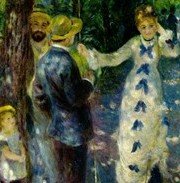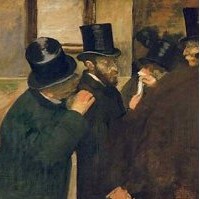|
|
In the first stage, he devotes himself
to fixing his impressions on detailed and almost elementary subjects.
He boldly places his still-life on white cloths which accentuate the shapes,
and the brilliance of colours is heightened by the use of black patches,
which he borrows from Manet. His first portraits, laid on in a thick paste,
with figures sometimes as large as life, stick strictly to the ideological
aim that he is pursuing. His father reading a novel stands out in front
of the whitish covering of his armchair. His friends Zola and Alexis are
curiously placed on a seat and cushions like oriental sages, divested
of all useless accessories or decor. (One cannot help thinking on the
other hand of Manet's portrait of Zola, almost contemporary, in which
the face counts for little while the composition includes everything calculated
to represent the man, his tastes and what interests him.) In this light
Cezanne's work then appears singularly bold and innovationist, which is
the main thing about it.
Cezanne is also the connecting
link between the future Impressionist
painters and the man who is to become their first ideological defender,
Zola. It is in innumerable discussions with Cezanne that Zola understands
the importance of Manet and realises the part he could play on his side.
In fact in 1866, the Salon jury, not wishing to see a repetition of the
Olympia scandal, reject all Manet's entries, including the "Fifer,"
at one swoop. Zola, who had agreed to write reviews of the Salon
for the new daily "L'Evenement," commenced his articles with
two attacks on the jury. In his third article he defines his own conception
of a work of art as being a combination of two elements, one fixed and
real, nature, and the other individual and subjective, the temperament
of the artist. He warns courageously against a conception too skimpy in
realism which, he says, is nothing unless it subordinates realism to temperament.
Having laid down these principles and even before beginning to review
the works exhibited, he devotes the whole of his fourth article to Manet
who in fact has been excluded from the exhibition. He puts on paper his
admiration not only for the "Fifer" but for earlier paintings:
"Le Diner sur L'Herbe" (as it was first titled) and "Olympia,"
and concludes by asserting that Manet's place, like that of Courbet, is
in the Louvre. Protests by readers
and subscribers are so strong that the editor decides to reduce the number
of articles by Zola and replace them with those of a more conformist critic.
Zola does not even write the three remaining articles commissioned from
him and, after a brief eulogy of Camille Corot (1797-1875), Charles
Daubigny (1817-78) and Camille Pissarro (1830-1903), ends his contribution.
But he publishes the whole of his articles in a booklet which he dedicates
to Paul Cezanne with whom he declares he will pursue alone the talks they
have had over ten years of life, often together, on the great problems
of artistic creation.
A year later, before the opening of the Universal Exhibition in which
Manet, like Courbet, has decided
to participate by renting a private stall in which he can show his works
quite freely, Zola publishes a long study of Manet and his works in which
he notes very pertinently the new contribution the artist has made to
art. As far as he is concerned Manet's forte lies in painting in solid
masses, of having discovered the tache (smudge), of always starting off
on a clearer note than exists in nature. He sees very clearly that in
the first and somewhat hard impression Manet's painting only shows delicacy,
that his colours are never piled up, nor are his effects forced, that
his values are true, his pallors strong and his simplicity quite up to
Museum standard. He comments impartially on his works, seeing in "Olympia"
the flesh and blood of the painter and emphasising the importance of his
new seascapes.
Today there is nothing much to change in these lines although they were
written while Manet was only halfway through his life's work. Simply remember
this definition by the painter Severini: "Here is the new process
of the tache, the exclusive search for tone and the new harmony of violet
shades. One might say that procedure counts little in art, that from Monet's
has come all modern painting."
Impressionist
Meetings in the Cafe Guerbois
Manet's pavilion in the exhibition of 1867
was not the success he had hoped for, while Courbet's, with some 110 works,
drew much more attention from the public as Manet's revived old quarrels.
In Manet's showing, however, is the essence of his work in fifty paintings,
presented in the most dignified and modest way with the painter simply
inviting the public to view "some sincere works". This exhibition
allows all the younger painters to measure the importance and the extent
of Manet's work. Only he was able to present so new and so significant
a collection of works. Even the idea of an exhibition was to be retained
by his comrades. Monet and his friends thought of taking a pavilion after
the exhibition closed to show, in their turn, works which could be presented
in a systematic fashion without the disadvantage of a neighbouring show.
Even if they were unable to find the money to stage the exhibition, it
still remained their aim. Zola's intervention on the side of Manet also
was to have lasting effects and give a theoretical adhesion to the meetings
of the young artists and writers.
Manet was in the habit, like other men about town of the period, of frequenting
a special cafe in the evening: first it was the Cafe de Bade at 26 Boulevard
des Italiens. But this cafe has many customers, of various types. Then
he shows a more marked preference for a smaller cafe at 11 rue des Batignolles
(now the Avenue de Clichy), the Cafe Guerbois. There he and his artist
and writer friends get into the habit of meeting. They are to be found
there every evening, according to individual liking, but every Thursday
they were all there. Manet was the elder, the leader, but while brimming
over with vivacity, always keeping to politeness and exquisite refinement
in discussion. Among those who were in the habit of meeting there were:
writers and critics like Zola, Duranty, Astruc, Duret, Burty, and Cladel;
artists like Fantin-Latour, Guillemet, Bracquemond, Degas, then Bazille,
Cezanne, Sisley, Monet, Pissarro and Desboutin; and just friends such
as Commandant Lejosne, the musician Maitre and the photographer Nadar.
At these brilliant meetings where wit flowed, sometimes sharp, Manet and
his writer friends, as well as Degas - redoubtable in discussion despite
his insistent monotone - at first had the lion's share of the discussion.
But gradually problems purely of pictorial interest, mainly of technique,
seem to take over and are debated with much seriousness. Monet, who listened
more than talked, perhaps shy from his upbringing, expounded his many
experiences. Cezanne interrupted with a vehemence sometimes not quite
understandable, to emphasise what he considered essential. Renoir, whose
mind was not theoretical, expressed his own personal non-conformist ideas
with humour and in a natural manner. Pissarro, who sometimes came up from
Louveciennes, impressed everyone with the generosity of his ideas and
the indomitable good nature of his convictions. From their discussions
and differences of opinion the group emerged more united and more friendly
and began to assume a well-defined shape. The meetings at the Cafe Guerbois
assumed importance from 1867 onwards and must essentially date from 1868
and 1869. If they did not survive the war it was because they had already
achieved their object: to permit the artists to know one another better
and to define their positions more clearly. At this stage discussion among
the artists had to give way to work. Moreover, it is symptomatic that
Fantin-Latour should
have preferred to place the group and his friends in a setting not in
the cafe but in an ideal imaginary studio. In this canvas, "A Studio
in Batignolles," painted in 1869 and exhibited in 1870, Manet is
sitting painting, surrounded by Renoir, Bazille, Monet, Astruc, Zola and
Maitre, and also the German painter Scholderer. In fact there were many
such meetings, not at Manet's place but at Bazille's studio. Bazille had
become installed near the Cafe Guerbois and left a small painting from
1870, free as a sketch, showing his friends and himself chatting and working.
In this work Manet and Monet are seen discussing the canvas which Bazille
is painting while Maitre plays the piano and Zola talks with Sisley. It
was Manet who painted the figure of Bazille.
See the art dealer and Impressionist
champion Paul Durand-Ruel.
Paintings by
Renoir, Sisley, Pissarro, Degas and Cezanne
LANDSCAPES
• Chemin
de la Machine, Louveciennes (1873) by Alfred Sisley.
Musee d'Orsay.
• The
House of the Hanged Man (1873) by Paul Cezanne.
Musee d'Orsay.
• Misty
Morning (1874) by Alfred Sisley.
Musee d'Orsay.
• Vegetable
Garden with Trees in Blossom, Spring, Pontoise (1877) Pissarro.
Musee d'Orsay.
• Path
Leading Through Tall Grass (1877) by Renoir.
Musee d'Orsay.
• The Red
Roofs (1877) by Pissarro.
Musee d'Orsay.
• Snow at
Louveciennes (1878) by Alfred Sisley.
Musee d'Orsay.
• The Bridge
at Maincy (1879) by Paul Cezanne.
Musee d'Orsay.
• Mont
Sainte-Victoire Paintings (1882-1906) by Paul Cezanne.
Various art museums.
URBAN LANDSCAPES
• Canal St Martin
(1870) by Alfred Sisley.
Musee d'Orsay.
• Boulevard
Montmartre paintings (1897-8) by Pissarro.
Various art museums.
FIGURE PAINTING
• The Ballet
Class (1871-4) by Degas.
Musee d'Orsay.
• Absinthe
(1876) by Degas.
Musee d'Orsay.
• Dance
at Le Moulin de la Galette (1876) by Renoir.
Musee d'Orsay.
• Luncheon
Of the Boating Party (1880-1) by Renoir.
Phillips Collection, Washington DC.
• The
Boy in the Red Waistcoat (1889-90)
E.G. Buhrle Collection; MOMA; Barnes Foundation; NGA Washington DC.
• Man
Smoking a Pipe (1890-2)
State Hermitage Museum, St. Petersburg.
• Woman
with a Coffee Pot (1890-5)
Musee d'Orsay, Paris.
• The
Card Players (1892-6)
Musee d'Orsay, Courtauld Gallery and others.
• Lady
in Blue (c.1900)
State Hermitage Museum, St. Petersburg.
• Young Italian
Woman Leaning on her Elbow (1900) by Paul Cezanne.
J. Paul Getty Museum, Los Angeles.
NEXT: (6) Claude
Monet and Camille Pissarro Travel to London.
Acknowledgements:
We gratefully acknowledge the use of an excerpt from Impressionism,
by Jacques Lassaigne (1966).
|


